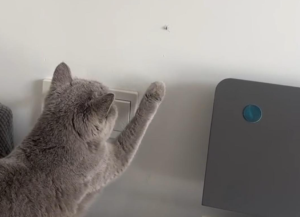Many cat owners wonder: If cats can’t be punished, how should you train them? What should you do when your cat ignores you during interactions? And how do you choose the best cat products? Well, today I’m going to reveal some insider secrets and tell you about the 4 major “bugs” in cat physiology. Once you know these, you’ll understand exactly how to handle your feline friend.
-
The “Cover” Bug
If you suddenly disappear behind some cover while your kitten is watching, that’s it—its curiosity instinct is immediately triggered. It will think, “What’s going on here? Is it mocking me?” and proceed to investigate. It will keep searching for you, looking, disappearing, looking again… and so on. This behavior is so typical that humans even named a game after it: hide and seek. Have you noticed that animated shows for cats use this bug too? The moment a small creature disappears off-screen, cats are instantly drawn to check behind the screen. So, how can you exploit this bug? Share your thoughts in the comments and let’s get creative together!
-
The “Space” Bug
No matter how a space is formed, if it’s just the right size for your cat to fit into, that’s its heaven. A cardboard box that fits just right, a trash can, a storage box, a drawer, a shelf gap, or even the space behind the toilet—all these are a cat’s favorite hiding spots. Now that you know about this bug, I’m sure you’ve got plenty of ideas on how to use it. Share them in the comments and let’s expand our cat care knowledge together!

-
The “Vision” Bug
Have you ever noticed this: when you move around in front of your cat, it doesn’t react, but as soon as you move one hand back and forth, it instantly goes into hunting mode? The cat’s vision bug is that it has trouble seeing large, static objects but can clearly spot small, moving ones—even recognizing the patterns on a mosquito’s wings. Its static vision is poor, but its dynamic vision is top-notch. If something is still and over 6 meters away, it’s blurry, but if prey moves more than 50 meters away, the cat can detect it. Even if it moves just 4 millimeters per second, the cat can spot it. Plus, cats are colorblind—they’re sensitive to blue and yellow, but have difficulty distinguishing red and green. Now that you know these bugs, you’ll be able to choose the best cat toys and products for them! Share your thoughts in the comments below.
-
The “Conditioned Reflex” Bug
Cats may not have the best memory, but they have a strong ability for conditioned reflexes, which can persist for a long time. Think about it: the sound of you pouring food or opening a can is a conditioned reflex that makes your cat excited, right? Negative conditioned reflexes work the same way. One cat owner bought their cat an amazing luxury cat tree, and the cat loved it. But one day, while the cat was resting on the tree, the owner trimmed its nails (which the cat hates). After that, the cat refused to go near the tree—it was banished to the cold corner.
Now that you know these bugs, have you come up with the perfect training methods? How can you teach your cat to stay away from places you don’t want it to go without punishment? How can you make your cat enjoy activities you want it to like? And what about getting your cat to stop doing things you don’t want it to do? I’m sure you all have your own brilliant methods—share them in the comments!So, fellow cat lovers, copy and paste your great wisdom and little tips from your brain into the comments section, and be sure to copy some of the smarter solutions you find there and stick them in your brain. Let’s reach the peak of cat parenting together!





